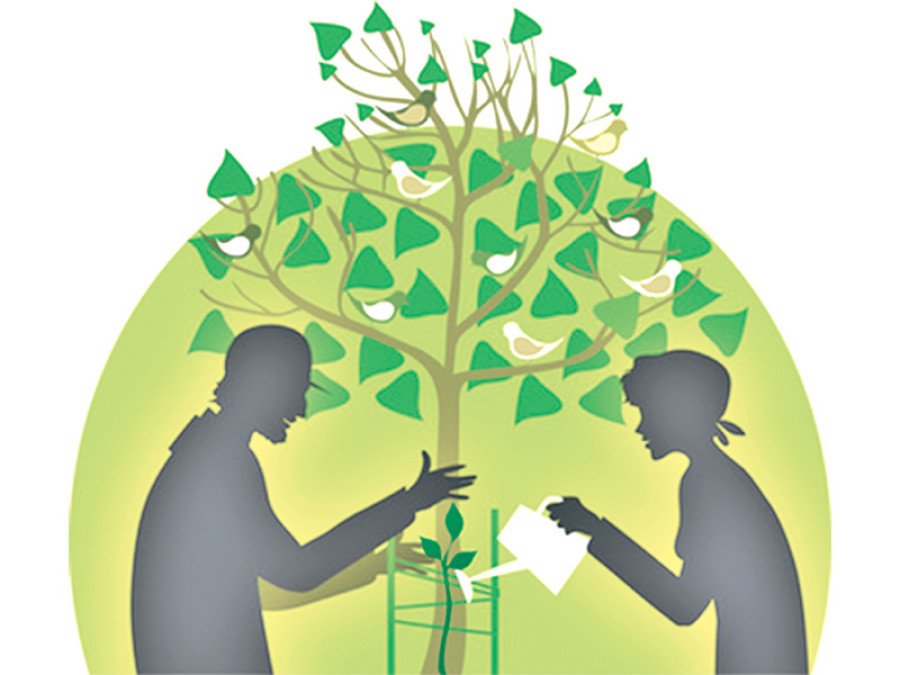Opinion
Move over, men
Several months ago, I visited a community forest in the mid-hills of western Nepal to understand how patriarchy was influencing community forestry practices.
Basundhara Bhattarai
Several months ago, I visited a community forest in the mid-hills of western Nepal to understand how patriarchy was influencing community forestry practices. A group of women told me that, among other unwanted changes, they were getting progressively less firewood from the community forest.
“Every year, when we carry out ‘godmel’ (forest thinning and pruning operations), we cut all inferior species (known as ‘kukath’) and retain ‘superior’ trees for timber. But we never thought how big timber trees would reduce the supply of firewood and fodder species,” they said. A woman in her 70s added, “I have seen that as timber trees grow bigger, smaller plants supplying firewood and fodder vanish.” I asked them if they could use branches and rejected portions of timber trees for firewood. They explained that when someone cuts down a tree for timber, the person is entitled to take the leftover branches. Another woman in her 50s said, “I will never get leftover branches as I have no plan to harvest timber trees for at least the next 10 years.”
These are just a few examples of women’s experience with community forestry. The way community forests are being managed, it does not seem that the voices and livelihood needs of women have been taken into account. Other regimes of forest management are even worse. This is not surprising because forestry remains under patriarchal control just like other decision-making matters. Despite devolution of power to the community, patriarchal dominance persists in everyday practices of silviculture, the science of managing forests.
Misplaced gender mainstreaming
In the glorious history of Nepal’s community forest management, which started in the 1970s, ‘gender mainstreaming’ and ‘women’s participation’ have been among the most cherished ideas in development policy circles. From development professionals to women’s rights activists, all have endeavored to ‘mainstream’ gender in natural resource management and development. In the political sphere, articulations of gender justice have been even more radical in the past decade. But in practice, what I find is not ‘mainstreaming’ but mistreatment of gender justice.
On the surface, one can notice some improvement in gender equity, but a closer look reveals that patriarchal dominance still prevails. According to community forestry rules, the number of women in decision-making positions (such as executive committee members of community forest user groups) must be equal to, if not greater than, that of men. The very objective of this policy is that every forest management plan should incorporate women’s knowledge and voices. However, in practice, this goal has rarely been achieved. I do not want to blame anybody as being solely responsible for the persistence of such gender injustice, which is rooted in the tradition of patriarchy. Patriarchy prevails in every domain of knowledge creation and political exercise, from silvicultural knowledge production to state forestry administration, and from NGO leaders to critical researchers.
Many of the technologies and practices implemented in the name of community forestry are influenced by this patriarchal order. Removing ‘inferior’ shrubs, which could have provided fodder, in favour of timber is not a decision supported by women. This has also not been actively resisted by women, either. We have a situation where both men and women perpetuate patriarchy to the detriment of themselves.
Devolved patriarchy
Despite major devolutionary shifts in forest governance, the retention of the timber-focused management model has subtly maintained masculine hegemony. This is practised by the community elite (mainly males) in collusion with forest officials. A woman in her 50s whom I met when she was feeding her livestock said, “I became chairperson of my community forest not because I know the duties of the chair, but because men put me there to impress the rangers and DFOs. My husband’s friends (the ‘tatha-batha’ of the village) told me that they would perform all the tasks on my behalf, but I would be named as the chair.” This way, men control the decisions of even officially women-led community forestry groups.
Right from the beginning, male dominated decision-making practices and gender insensitive forest science have worked to keep community forestry focused on the singular objective of timber production. This science-patriarchy nexus imposes a tremendous negative impact on women’s everyday life and livelihoods. Silviculture views timber as the main product, and does not allow feminine knowledge or women’s voices in community forest management practices.
The whole exercise of growing trees has become a man’s business—in the academy, government, civil society and finally the local community. In the hills of Nepal, women are the ones who collect fuel wood, fodder and water and perform other daily chores.
With male outmigration increasing, women’s responsibilities have expanded further, but there has been no corresponding increase in access to decision-making roles.
This is a big challenge to the promoters of community forestry who have failed to dismantle gender-based injustices in forest science, forest management practices, local institutions and policy dynamics. The faulty conception of gender mainstreaming has limited gender justice endeavors to a ‘number game’, setting aside more fundamental questions from the debate.
Critical gender studies in the forestry sector is also lacking, as the overwhelming majority of the male workforce—in the government, civil society and private sector—has been embroiled in the patriarchal ideologies and apparatus of forest governance that have evolved over many decades. The future of gender inclusive forestry depends on critical discourse and the work of champions of change who can
recognise subtle patriarchal roots of gender injustice.
Bhattarai holds a PhD on gender and environment from the University of Melbourne, Australia




 11.12°C Kathmandu
11.12°C Kathmandu











